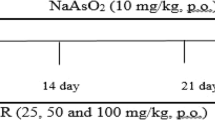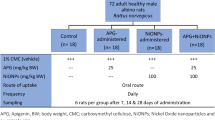Abstract
Nickel, a major environmental pollutant, is known for its clastogenic, toxic, and carcinogenic potential. In this article, we report the effect of Acorus calamus on nickel chloride (NiCl2)-induced renal oxidative stress, toxicity, and cell proliferation response in male Wistar rats. NiCl2 (250 μmol/kg body weight/mL) enhanced reduced renal glutathione content (GSH) glutathione-S-transferase (GST), glutathione reductase (GR), lipid peroxidation (LPO), H2O2 generation, blood urea nitrogen (BUN), and serum creatinine with a concomitant decrease in the activity of glutathione peroxidase (GPx) (p<0.001). NiCl2 administration also dose-dependently induced the renal ornithine decarboxylase (ODC) activity several-fold as compared to salinetreated control rats. Similarly, renal DNA synthesis, which is measured in terms of [3H] thymidine incorporation in DNA, was elevated following NiCl2 treatment. Prophylactic treatment of rats with A. calamus (100 and 200 mg/kg body weight po) daily for 1 wk resulted in the diminution of NiCl2-mediated damage, as evident from the downregulation of glutathione content, GST, GR, LPO, H2O2 generation, BUN, serum creatinine, DNA synthesis (p<0.001), and ODC activity (p<0.01) with concomitant restoration of GPx activity. These results clearly demonstrate the role of oxidative stress and its relation to renal disfunctioning and suggest a protective effect of A. calamus on NiCl2-induced nephrotoxicity in a rat experimental model.
Similar content being viewed by others
References
S.J. Duthie, A. Ma, M.A. Rose, and A.R. Collins, Antioxidant supplementation decreases oxidative DNA damage in human lymphocytes, Cancer Res. 56, 1291–1295 (1996).
J. A. Larrauri, C. Sanchez-Moreno, P. Ruperez, and F. Saura-Calixto, Free radical scavenging capacity in the aging of selected red Spanish wines, J. Agric. Food Chem. 47, 1603–1606 (1999).
D. Stajner, N. Milic, B. Lazic, and N. Mimica-Dukic, Study on antioxidant enzymes in Allium cepa L. and Allium fist ulosum L, Phytother. Res. 12, S15-S17 (1998).
D. Malencic, O. Gasic, M. Popovic, and P. Boza, Screening for antioxidant properties of Salvia reflexa Hornem, Phytother. Res. 14, 546–548 (2000).
P. Grandjean, Human exposure to nickel, IARC Sci. Publ. 53, 469–485 (1984).
M. Knopfel, G. Schulthess, F. Funk, and H. Hauser, Characterization of an integral protein of the brush border membrane mediating the transport of divalent metal ions, Biophys. J. 79, 874–884 (2000).
M. Costa, J. Simmons-Hansen, C. W. M. Bedrossian, J. Bonura, and R. M. Caprioli, Phagocytosis, cellular distribution, and carcinogenic activity of particulate nickel compounds in tissue culture, Cancer Res. 41, 2868–2876 (1981).
H. Cangul, L. Broday, K. Salnikow, et al., Molecular mechanisms of nickel carcinogenesis, Toxicol. Lett. 127, 69–75 (2002).
K. S. Kasprzak, F. W. Sunderman, and K. Salnikow, Nickel carcinogenesis, Mutat. Res. 533, 67–97 (2003).
C. Wataha, P. E. Lockwood, A. Schedle, M. Noda, and S. Bouillaguet, Ag, Cu, Hg and Ni ions alter the metabolism of human monocytes during extended low-dose exposures, J. Oral Rehabil. 29, 133–139 (2002).
R. L. Messer and L. C. Lucas, Evaluations of metabolic activities as biocompatibility tools: a study of individual ions effects of fibroblasts, Dent. Mater. 15, 1–6 (1999).
R. L. Messer, S. Bishop, and L. C. Lucas, Effects of metallic ion toxicity on human gingival fibroblasts morphology, Biomaterials 20, 1647–1657 (1999).
M. Misra, R. E. Rodriguez, and K. S. Kasprzak, Nickel induced lipid peroxidation in the rat: correlation with nickel effect on antioxidant defense systems, Toxicology 64, 1–17 (1990).
M. Costa and C. B. Klein, Nickel carcinogenesis, mutation, epigenetics, or selection, Environ. Health Perspect. 107, A438-A439 (1999).
L. A. Garner, Contact dermatitis to metals, Dermatol. Ther. 17, 321–327 (2004).
B. N. Ames, M. C. Hollstein, and R. Cathcart, in Lipid Peroxides in Biology and Medicine K. Yagi, ed., Academic, New York, pp. 339–351 (1982).
M. Athar, S. K. Hasan, and R. C. Srivastava, Evidence for the involvement of hydroxyl radicals in nickel mediated enhancement of lipid peroxidation: implications for nickel carcinogenesis, Biochem. Biophys. Res. Commun. 147, 1276–1281 (1987).
N. Nishiyama, Y. Zhou, and H. Saito, Beneficial effects of DX-9386, a traditional Chinese prescription, on memory disorder produced by lesioning the amygdale in mice, Biol. Pharm. Bull. 17, 1679–1681 (1994).
Y. Zhang, K. Takashina, H. Saito, and N. Nishiyama, Anti-aging effects of DX-9386 in senescence-accelerated mouse, Biol. Pharm. Bull. 17, 866–868 (1994).
L. V. Asolkar, K. K. Kakkar, and O. J. Chakra, in 2nd Supplement to Glossary of Indian Medicinal Plants with Active Principles, CSIR (1992).
P. S. Vaidyaratnam, in Varier's Indian Medicinal Plants Oriental Longman Ltd, Arya Vaidya Sala, Kottakal, p. 51 (1994).
P. K. Shukla, V. K. Khanna, M. M. Ali, R. R. Maurya, S. S. Handa, and R. C. Srimal, Neuroprotective effect of Acorus calamus against acrylamide induced neurotoxicity, Phytother. Res. 15, 1–5 (2001).
P. C. Dandiya and H. Cullumbine, Studies on Acorus calamus (III): some pharmacological action of the volatile oil, J. Pharm. Exp. Ther. 125, 353–359 (1959).
G. V. Satyavati, M. K. Raina, and M. Sharma, in Medicinal Plants of India Indian Council of Medical Research, New Delhi, Vol. 1, pp. 6–7 (1976).
J. S. Cho, Y. H. Kim, J. Y. Kong, C. H. Yang, and C. G. Park, Protection of cultured rat cortical neurons from excitotoxicity by asarone, a major essential oil component in the rhizomes of Acorus gramineus, Life Sci. 71, 591–599 (2002).
B. Y. Hu and Y. Y. Ji, Research on the anticarcinogenic activation of Acorus calamus. Anticarcinogenic activation of α-asarone on human carcinoma cells, Zhong Xi Yi Jie He Za Zhi 6, 480–483 (1986).
G. A. Burdock. Fenaroli's Handbook of Flavour Ingredient, CRC, Boca Raton, FL, Vol. 1 (1970).
V. K. Raina, S. K. Srivastava, and K. V. Syamasunder, Essential oil composition of A. calamus L. from the lower region of the Himalayas, Flavour Fragr J. 18, 18–20 (2003).
D. J. Jollow, J. R. Mitchell, N. Zampaglione, and J. R. Gillete, Bromobenzene induced liver necrosis: protective role of glutathione and evidence for 3,4, bromobenzene oxide as the hepatotoxic intermediate, Pharmacology 11, 151–169 (1974).
W. H. Habig, M. J. Pabs, and W. B. Jokoby, GST: the first enzymatic step in mercapturic acid formation, J. Biol. Chem. 249, 7130–7139 (1974).
I. Carlberg and B. Mannervick, Glutathione reductase level in rat brain, J. Biol. Chem. 250, 5575–5580 (1975).
J. R. Wright, H. D. Colby, and P. R. Miles, Cytosolic factors that affect microsomal lipid peroxidation in lung and liver, Arch. Biochem. Biophys. 206, 296–304 (1981).
M. W. Kanter, Clinical Chemistry, Bobbs Merill Co. (1975).
R. S. Hare, Endogenous creatinine in serum and urine, Proc. Soc. Exp. Biol. Med. 74, 148 (1950).
E. Pick and Y. Keisari, A simple colorimetric method for the measurement of hydrogen peroxide produced by cells in culture, J. Immunol. Methods, 38, 161–170 (1980).
J. Mohandas, J. J. Marshall, G. G. Duggin, J. S. Horvath, and D. Tiller, Differential distribution of glutathione and glutathione related enzymes in rabbit kidney, Cancer Res. 44, 5086–5091 (1984).
T. G. O'Brian, R. C. Simsiman, and R. K. Boutwell, Induction of the polyamine biosynthesis enzymes in mouse epidermis by tumor promoting agents, Cancer Res. 35, 1662–1670 (1975).
R. C. Smart, M. T. Huang, and A. H. Conney, Sn 1,2-diacylglycerols mimic the effects of TPA in vivo by inducing biochemical changes associated with tumor promotion in mouse epidermis, Carcinogenesis 7, 1865–1870 (1986).
K. W. Giles and A. Myers, An improved diphenyl method for the estimation of deoxyribonucleic acid, Nature 206, 93–98 (1965).
O. M. Lowry, N. J. Rosenbrough, A. L. Farr, and R. J. Randall, Protein measurement with folin phenol reagent, J. Biol. Chem. 193, 265–275 (1951).
S. Karkabounas, D. Assimakopoulos, M. Malamas, A. L. Skaltsounis, and S. Leonce, Antiproliferative and anticarcinogenic effects of a aqueous preparation of Abies alba and Viscum album se abies, on a L-1210 malignant cell line and tumor bearing Wistar rats, Anticancer Res. 20, 4391–4395 (2000).
A. R. Opoku, M. Geheeb-Keller, J. Lin, S. E. Terblanche, and A. Hutchings, Preliminary screening of some traditional Zulu medicinal plants for antineoplastic activities versus the Hep G2 cell line, Phytother. Res. 14, 534–537 (2000).
N. Khan and S. Sultana, Chemomodulatory effect of Ficus racemosa extract against chemically induced renal carcinogenesis and oxidative damage response in Wistar rats, Life Sci. 77, 1194–1210 (2004).
R. A. Floyd, M. S. West, K. L. Eneff, W. E. Hogsett, and D. T. Tingey, Hydroxyl free radical medicated formation of 8-hydroxyguanine in isolated DNA, Arch. Biochem. Biophys. 262, 266–272 (1988).
W. E. Fahl, N. D. Lalwani, T. Watanabe, S. K. Goel, and J. K. Reddy, DNA damage related to increased hydrogen peroxide generation by hypolipidemic drug induced liver peroxisomes, Proc. Natl. Acad. Sci. (USA) 81, 7827–7830 (1984).
K. M. Prise, S. Davis, and B. D. Michael, Cell killing and DNA damage in Chinese hamster V79 cells treated with hydrogen peroxide, Int. J. Radiat. Biol. 55, 583 (1989).
Author information
Authors and Affiliations
Rights and permissions
About this article
Cite this article
Prasad, L., Khan, T.H., Jahangir, T. et al. Acorus calamus extracts and nickel chloride. Biol Trace Elem Res 113, 77–91 (2006). https://doi.org/10.1385/BTER:113:1:77
Received:
Revised:
Accepted:
Issue Date:
DOI: https://doi.org/10.1385/BTER:113:1:77




